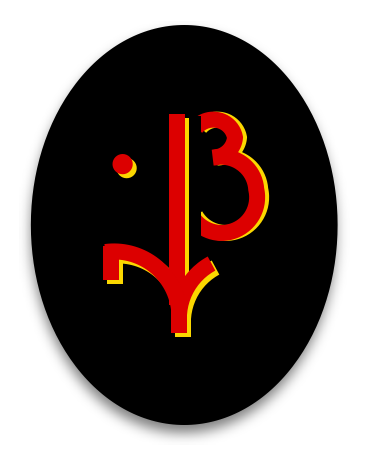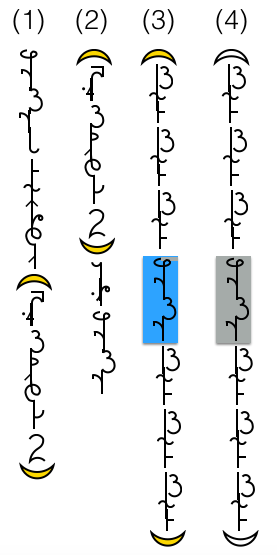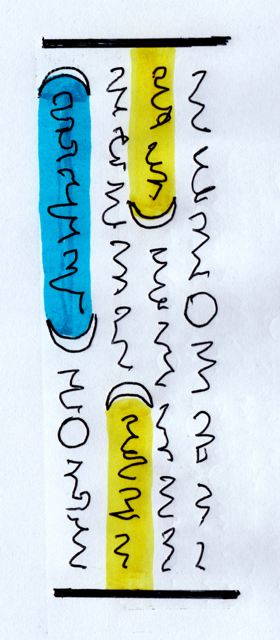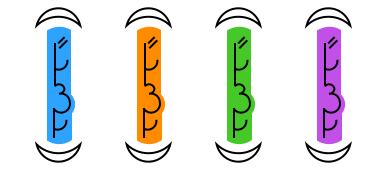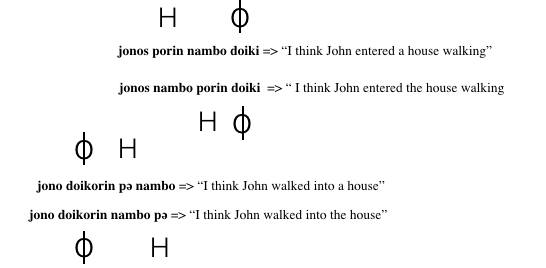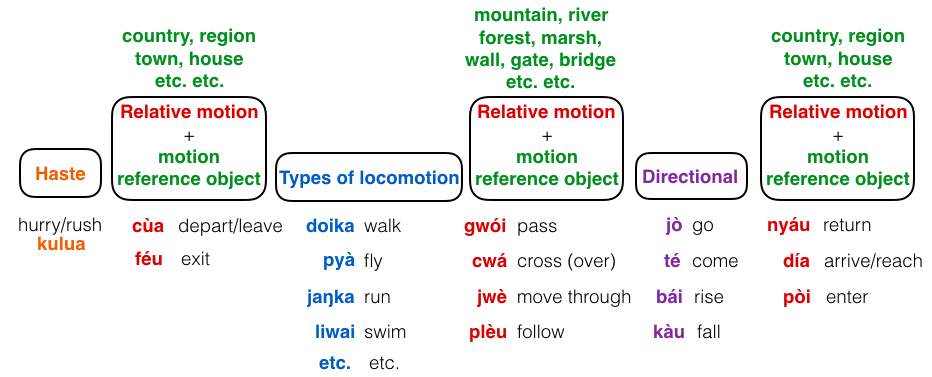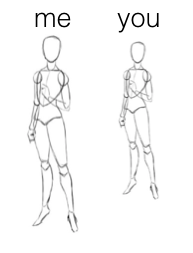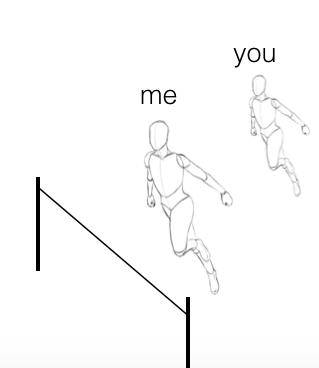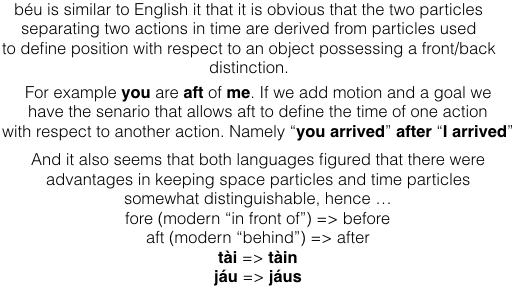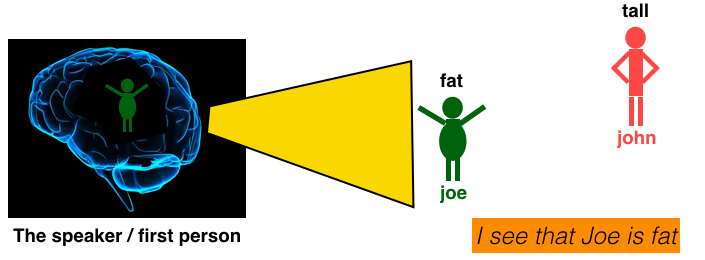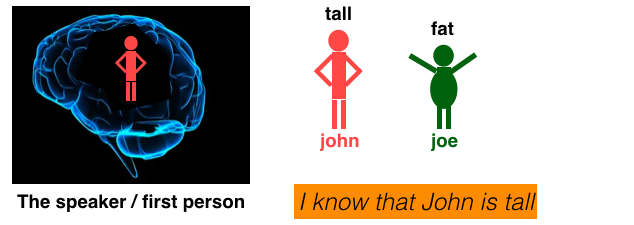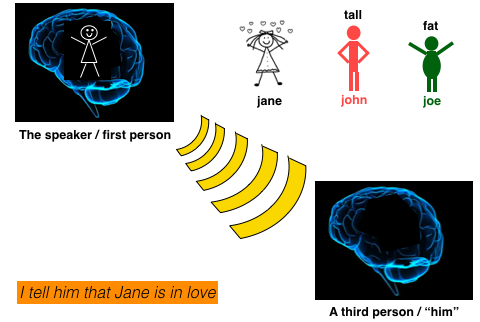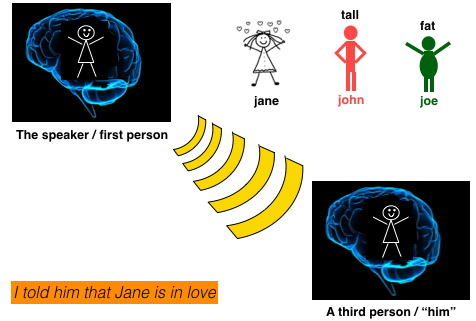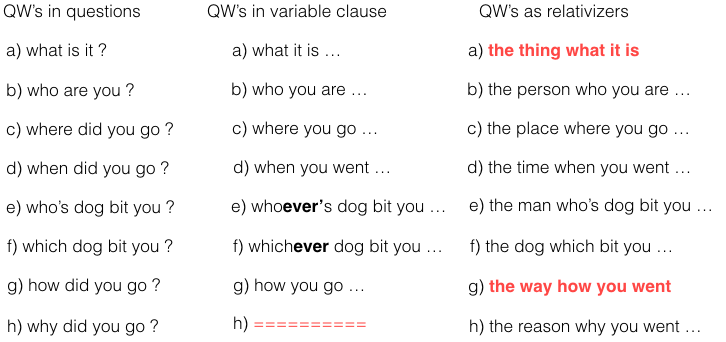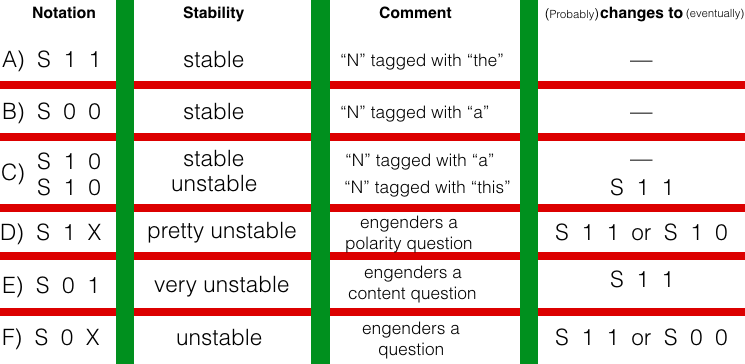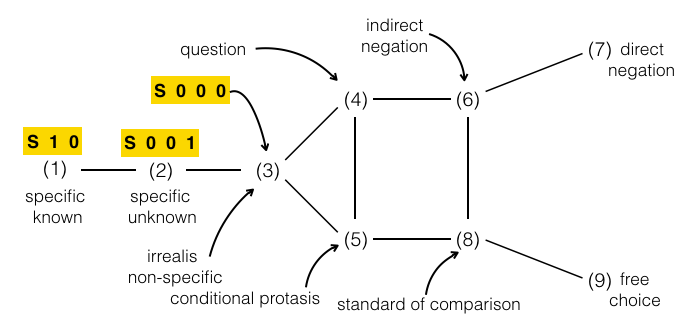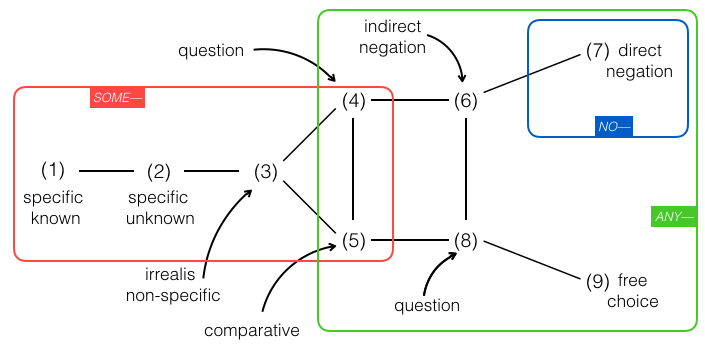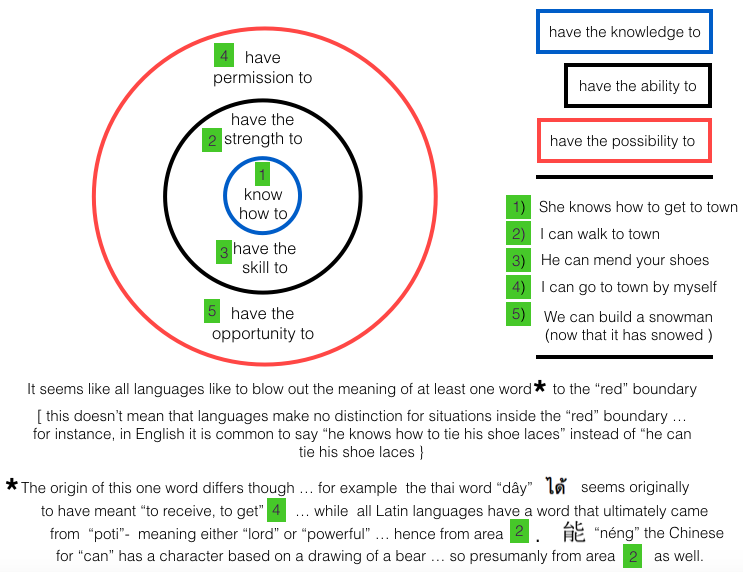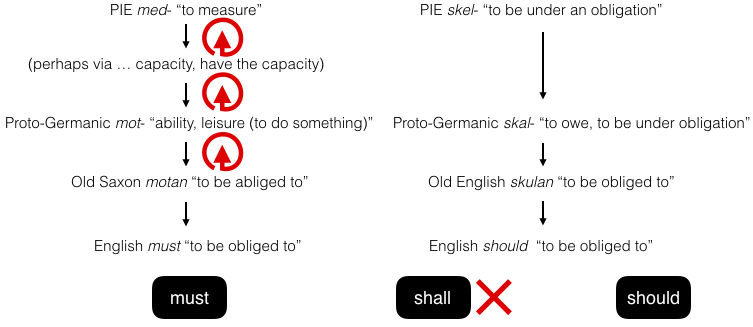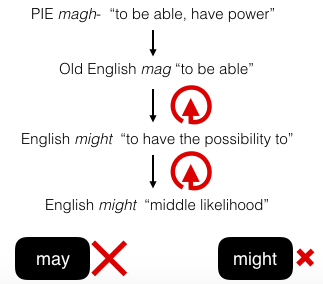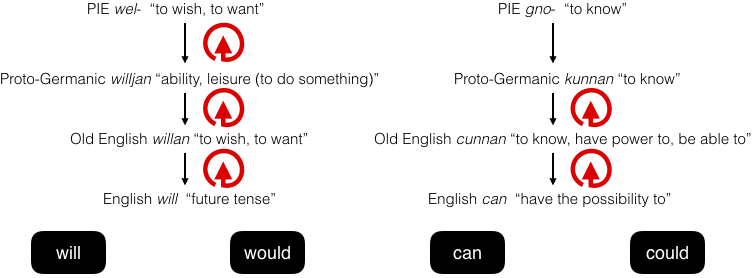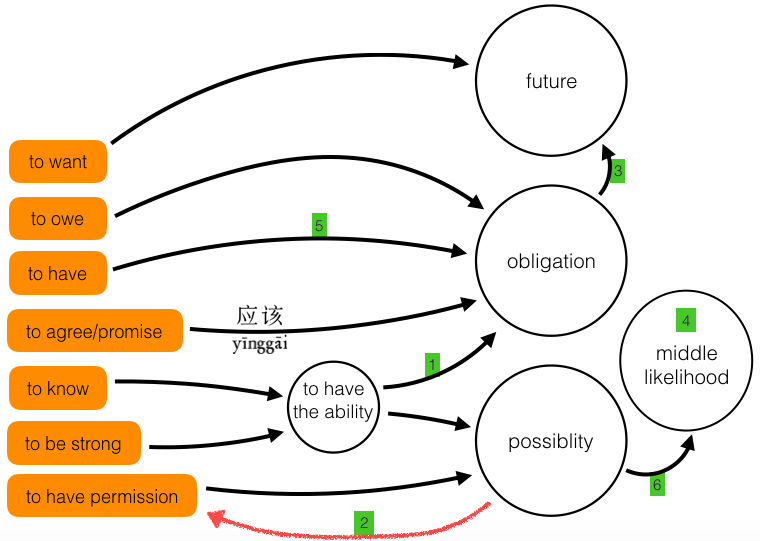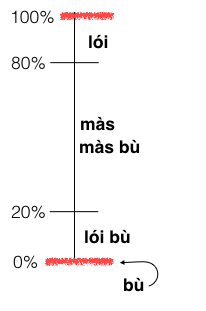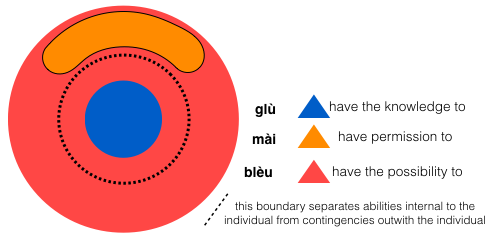Béu : Chapter 10 : Gerund Phrase
..... Direct/indirect/base speech
..
1) Direct speech is the speech reported exactly as it was spoken : the string of words reported are identical to the original string of words. Time and person are reported as they are to the originator of the speech.
2) Indirect speech gives the same information as (1), but with time and person (and mood) relative to the reporter of the speech.
3) Base speech is when the original string of words is severely curtailed. Usually reduced to an infinitive plus a modifier. (See examples E1 and E3) I call this base speech because I call infinitives, "base forms" (of the verb).
..
Direct speech is the more basic than indirect speech. Many of the worlds languages only have direct speech. However in béu (as in English) there are both types.
...
In the following examples, (A) demonstrates direct/indirect speech for statements, (B)/(C) demonstates direct speech for a question (indirect speech not allowed), (D) demonstrates direct/indirect speech for a command and (E) demonstrates direct/base speech for a command.
Also direct speech examples will have a 1 in their index, Indirect speech examples will have a 2. Base speech will have a 3.
..
A1a) jonos swori _ sàr tumu = John said, I am stupid
A2) jonos swori gò sori tumu = John said that he was stupid ... notice : 1SG => 3SG : aortist => past
Actually (A1a), while acceptable, it very rare. The more usual way to express this is ...
A1b) sàr tumu sói jono
In this construction ...
The name of the "originator of the speech" always follows the particle sói.
The name of the "originator of the speech" is always in base form (i.e. not ergative form)
The "originator of the speech" + sói are always inserted in the first breathing space. OK ... in the example here, because the speech (sàr tumu) is so short, "originator of the speech" + sói follows the whole thing.
béu speakers feel it the pattern in (A1a) is unduly formal or "stiff", especiately when a story is being narrated.
This pattern exhibited by (A1b) can sometimes be observed in English : "I wonder, she said, what will become of us"
Etymologically sói probably derived from swori ... the 3SG + past tense form of swé "to say". However now it is a particle rather than a verb. While "pasr tense" remains an integral part of the word," third person singular" no longer is. sói can be used with any "person". For example ... sàr tumu sói pà : "I am stupid, said I"
[In the béu writing system, there is never a break before sói and always a break after swori. This is a pretty accurate depiction of béu pronounciation]
..
B1) jenes alkori _ tìa njiru ʔai? : Jane asked, "will you go home"
C1) jenes alkori _ mís tìa njoru : Jane asked, "who will go home"
[Note : It would be optimum design if the only time you heard such question words as ?ai? and mís were in actual questions. However to make a rule which would rid reported speech of such would make more problems than it would solve(for instance a rule saying mís > mìs, nós > nòs etc. etc. in reported speech). Anyway, when you are reporting questtions, swori or alkori or whatever always comes before the reported string, so the listener should be prepared for a QW which doesn't elicit an answer.]
..
D1a) nju tìa sói jono : "return home", said John
D2a) jonos swori gò byór njua tìa : "John said that he/she must return home"
Now depending on how "originator of the speech", "speech auditor", "reporter", "report auditor" and "third party" are related, and on the plurality of these five parties, any of the forms byár, byáir, byáur, byír, byér or byúr could also be appropriate above.
And maybe (perhaps based on how forcefully John spoke) the appropriate indirect speech equivalent would be ...
D2b) jonos swori gò yór njua tìa : "John said that he/she should return home"
And maybe (perhaps based on some knowledge of the situation ... getting inside John's head to a certain extent) the appropriate indirect speech equivalent would be ...
D2c) jonos swori gò sòr boʒi gò njor tìa
D2d) jonos swori gò sòr neʒi gò njor tìa
D2e) jonos swori gò sòr wái gò njor tìa
[See the section titles "the particle gò in Chapter 4, for an explanation of the above]
..
E1) John to-us told/ordered/commanded _ return home
jonos manun oldori _ nju tìa .......... [Note to self : check that oldo = order, command]
..
E3) John to-us told/ordered _ return home
jonos manunn oldori njua tìa
Here njua is a base (a noun), tìa modifies this noun
..
Note : I believe that Latin had a separate word for "say" which was only used for insertions (as sói is used). This was inquam/inquit
..
Actually béu uses its take on quotation marks to delineate direct speech ...
(1) jenes alkori _ tìa njiru ʔai? : Jane asked, "will you go home"
(2) tìa njiru ʔai? sói jene : "will you go home" said Jane
(3)+(4) blaa blaa blaa sói jene blaa blaa blaa
..
Notice that sói is not actually written in (3) and (4) although it will havw been articulated.
(3) this is the normal way to write. (4) but sometimes a grey-scale scheme is ised.
..
In a textblock, which you have a lot of dialogue it is common to colour code the strings of direct speech with respect to the speaker. For example ...
When this happens the quotation marks deupa have no gold filling. It could be possible to drop the speakers name also once the colour coding scheme is established. This really depends upon how much dialogue is involved. Maybe each speaker would be mentioned again at the start of every textblock ... just to keep the protagonist <=> colour mapping alive in the readers mind.
..
Finally an insight from Otto Jespersen …
Human forgetfulness or incapacity to keep up for a long time the changed attitude of mind implied in indirect discourse causes the frequent phenomenon that a reported speech begins indirectly and is suddenly continued in the direct form, In Icelandic sagas this is common. For example … "mælti at hann skyldi gera til brauð þeira, en ek man sökja eldivið" : "he said that he (the other) was to prepare their bread, but I will fetch fuel".
The above doesn’t apply to béu especially. But I thought it was worth including here.
..
..... Other verbs of speech
..
We have already briefly touched on serial verb chains. These are in fact the i-form of the verb.
The i-form of swé is often used to give strings of direct speech in conjuction with another verb. Usually this other verb denoted some time of speech event. There are around 50 speech-verbs in béu ... melita "to agree" : noluja "to disagree" : malapa "to equivocate" : : oldo "to order/command" : endo "to introduce/recommend" : enji "to suggest" : ʔuaho "to exclaim" : ʔaume "to scream" : uhozo "to exhort/urge" : dauŋgo "to repeat/relay" : diŋkli "to discuss" : dawata "to haver" : daumpa : "to scold/berate" ... etc. etc.
..
uhozo is an S-verb meaning "to urge", "to exhort".
So you could use uhozo as the main verb in the clause and then can add the sods marked with swə ...
uhozora jenes jono ... gì r boimos swə => Jane is cheering on John shouting "you are the best"
..
| uhoz-o-r-a | jene-s | jono | gì | r | boimos | swə |
|---|---|---|---|---|---|---|
| "exhort"-3SG-IND-PRS | Jane-ERG | John | you | COP | the best | saying |
..
dauŋgo is an S-verb meaning "to repeat, to relay"
tomos dauŋgore jene swə gì r boimos = Thomas repeated Jane saying "you are the best"
..
The i-form of aika is also used fo give "sods". For example ...
daulau is an NS-verb meaning "to joke".
daulori jene jonotu aiki bla bla bla => Jane joked with John asking bla bla bla (well to make this a good example I would have to invent a quite involved scenario, but I hope you get the idea ... even with the ellipses)
..
The use of alki and swə in conjunction with one of the speech act verbs are an important structure in béu grammar and adds to the beauty and functionality of the language.
This structure is really only applicable to speech act verbs. If it was used with a non-speech-act verb it would sound a bit strange to the ear of a béu speaker. For example ...
?jono doikori dunheun swə falaja r NICE sowe = John walked to the civic centre saying "what a beautiful morning"
..
béu maintains a dichotomy between speech-verbs and thought-verbs. Speech-verbs can take a swə/aiki adjunct whereas thought-verbs can take a complement clause introduced by the particle gò in place of an O argument. We will go into this more in the next section.
This dichotomy is not total though. There is some merging between the two constructions.
For example ... liza "to hear" may be considered unique w.r.t. the constructions it can appear in ...
lizari jwadoi = I heard some big birds
lizari jono = I heard John
lizari jono swé bù ʔár jò = I heard John say "I don't want to go" ....... OK I suppose we analyze swé bù ʔár jò as an adjuct similar to swə bù ʔár jò in jono nolujori swə bù ʔár jò "John disagreed saying "I don't want to go"
lizari gò jono bù jorua I heard that the jono doesn't intend to go
lizari swər bù jarua = I heard it said "I will not go" .............. And we can analyze this as an transitive verb where the object has been dropped.
Also glùn "to inform, to tell" is both a thought-verb and a speech-verb. The informer is in the ergative, the informed the dative. The object can be an object (i.e. the news) or a complement clause (i.e. gò jono bù jorua) or it can simply be missing (when we use glùn as a speech-verb) ... or should we consider that when it is used as a speech-verb that there is an object ... something generic like "the news" but that it can be dropped. Well neither answer is right in itself.
..
..... Interesting words and meanings
..
1) An abnormal gait (walk), typically caused by some lower body problem.
1a) Manner of walking (no connotation of injury)
1b) [by metaphoric extention] ... a foible
2) An incapacitating injury (usually stopping mobility)
2a) Achiles heel.
XXXia = cripple
3) We have a couplet meaning "drinking and scrounging"
4) Binary, dichotomy ...... "binary phrase" // What is a binary phrase = b.p. = "whether/if I did that" in the sentence "I can't remember if I did that" ...... béu does not have any b.p.
5) njua is a transisive verb. The location is not marked with -n. The subject is marked with -s. The location is often highly topical and hence dropped. (It is always "return home" not "go home" ... assuming of course that the subject has been to the "home" before.
6) kli.o = knife, mitu = fork, klimitu = cutlery
7) kebo = side, flank
8) áus = a period of time
9) yoto = a drop : yota = to drip ... iyoto ?
..
9) kekeu = cake from Korean
10) sawin = state/condition ..... the copula sàu with the past passive marker -in ?
.. nawin = gift/present ..... the verb náu with the past passive marker -in
..
..
..... Conflative clauses
..
We have touched on this construction in Ch 3.1.8. Now we will go over it thoroughly.
..
..... The ordering of conflative clause elements
..
Let us start with discussing the possible order of elements in the conflative clause. To kick of we can consider the 4 examples below.
..
..
And breaking down the first and last of the four examples ...
| jono-s | p-o-r-i-n | tìa | doiki |
|---|---|---|---|
| John-ERG | enter-3SG-IND-PAST-EV3 | house | walk(i-form) |
| jono | doik-o-r-i-n | tìa | pə |
|---|---|---|---|
| John | walk-3SG-IND-PAST-EV3 | house | enter(i-form) |
By the way, EV3 is short for "the third evidential" ... it should be possible to parse the other two examples from these break downs.
..
The above is basically the same scene described 4 different ways. They differ as to the definiteness of "the house". Other differences are hard to talk about with no knowledge of the body of text in which these clauses are embedded ... but remember that "new information" usually comes last.
I have marked transitive verbs with ![]() and intransitive verbs with
and intransitive verbs with ![]() as I usually do.
as I usually do.
There is no restrictions on word order when we only have one ![]() in a clause.
in a clause.
Now if you glance back to Ch 3.1.8 you can see the example there had 3 sensequtive transitives which all had the same object. The restriction here is that the object can not come between any of the verbs. I have reproduced the example below (well with a bit of embellishment) ...
I have joined up the transitive signs ... this represents the fact that the object can not come between these verbs.
Now let us call an H sign a "fence". Also let us call a double-H sign a "fence" and a treble-H sign ... and so on.
Now let's elaborate the above example a little bit ...
We have added another verb ... the extra verb is intransitive but its object it different from the object of the other intransitive verbs. The above example actually is NOT ALLOWED.
Schematically the extra H can not be absorbed into existing "fence" because their objects are not identical. Now when you have two adjacent "fences" (i.e. no intransitive verb between), then both objects must come in front of their respective fences. The above example is shown below in an acceptable form ...
| jana | jono-s | léu | fiʒi | hold-o-r-i-s | slanji | flə | ?azwo | lata | solbi |
|---|---|---|---|---|---|---|---|---|---|
| yesterday | John-ERG | three | fish | catch-3SG-IND-PAST-EV4 | cook(i-form) | eat(i-form) | milk | cow | drink(i-form) |
=> They say yesterday John caught cooked and ate three fish. Also they say he drank cow's milk.
The two word orders shown below would be also NOT ALLOWED.
This stipulation of OV sort of balances the VO stipulation for manga phrases.
..
So when it comes to syntax in conflative clauses, there are two rules ...
(1) In a sequence of H verbs which share one object, this object CAN NOT come between the verbs.
(2) If two sequences of H verbs (i.e. two "fences") are adjacent, then the relevant object MUST precede the sequence it applies to.
In the envoironment mentioned is (2), we of course loose the definite/indefinite distinction.
..
..... The time structure of a conflative clause
..
In the previous section we talked about catching, cooking and eating some fish. Now in this case LOGIC dictates that these three activities happened in a certain order. And it is not surprising that béu insists on the verbs appearing in this logical order. This is conflative clause with "sequential order".
Other conflative clauses have a "simultaneous order". For example ...
..
| jono | doik-o-r-e | komwe | plə | wiʒi |
|---|---|---|---|---|
| John | walk-3SG-IND-ETD | road | follow(i-form) | whistle(i-form) |
=> Earlier today John walked along the road whistling
By the way ETD = "earlier today" ... with doika ɸ "to walk" : plèu H "to follow" : wiza H "to whistle"
Note ... wiza is a transitive verb, even though in 99% of cases the object is dropped.
..
Now in this case the three actions are assumed to occur at the same time. Hence there are 6 ways that this scene can be expressed ...
1) jono doikore komwe plə wiʒi ... ɸ H H
2) jono doikore wiʒi konwe plə ... ɸ H H
3) jonos komwe pore wiʒi doiki ... H H ɸ
4) jonos komwe pore doiki wiʒi ... H ɸ H
5) jono wizore komwe plə doiki ... H H ɸ
6) jono wizore doiki komwe plə ... H ɸ H
(4) and (6) are allowed to let "to follow" and "road" to change places ... enabling a distinction between "the road" and "a road" (see the section above).
..
And yet other conflative clauses have an "interleaved order". For example ...
..
| falaja | ú | fyakas | klud-a-r-i | sweno | nyauʒi |
|---|---|---|---|---|---|
| afternoon | whole | report(noun) | write-1SG-IND-PAST | telephone(noun) | answer(i-form) |
=> All afternoon I was writing reports and answering the telephone
In this case the two actions were randomly interleaved ... a bit of one followed by a bit of the other. When the action is interleaved like this, then the verbs can come in any order. So ... falaja ú sweno nyauzari kludi fyakas ... means exactly the same thing.
So basically when the time structure of a conflative clause is sequential the verbs must be in a certain order. When the time structure of a conflative clause is simultaneous or interleaved the verbs can be in any order.
Note that in these three examples, that the internal time structure of the composite action (i.e. simultaneous, interleaved and sequential) are never formally stated. Rather they are known due to the listeners knowledge of the situation being described. Sometimes the time structure of a situation is not clear. If it is thought necessary to clarify a conflative clause can not be used and one must use multiple clauses with the relevant conjunction joining them.
You can continue adding i-form verbs indefinitely. However if the subject changes, you have to go back to an r-form.
[Note ... Although the verb chain is the common way to express when two actions happen at the same time, another method is possible. That is to make one of the verbs into an adjective. And then by placing this directly behind another verb you get an adverb. For example ... wizari doikala = I whistled while I walked]
..
..... Conflative clause and motion
..
Verb chains are used a lot for verbs of motion. In certain languages (for example Cantonese, verbs do the job that prepositions do in European languages. Now béu does have a set of prepositions (the pilana). So for defining exactly what non-core NP's are doing in a sentence (that is everything that is not S, A or O) ... in béu this task is shared about equally between prepositions and minor verbs.
The rules are the same as stated in the previous section.
Now as you would expect, there are preferred orders. The diagram below shows the order that would probably be used for a future tense situation. Also this order would be preferred if someone was narrating a story and wanted to keep everything in sequence. For example ...
jene corua doiki pofe jwə london də => "Jane intends to walk through the forest to London" (from here)
jene cori doiki pofe jwə london də => "Jane walked through the forest to London" (from here)
However in other situations*, the actual sequence of individual events might be deemed less relevant, and there might be a tendancy to place the most important/surprising** event to the left. (No example)
?ari gàu bù blə = I wanted to do it but could not.
?ari náu toili gìn bù blə = I wanted to give you the book but could not.
?ár náu toili gìn bù blə = I want to give you the book but can not.
kulua is leftmost, if present .... also ulpa "to make a mistake"
*For a verb chain that was ongoing. There would be a tendency for the first verb of unrealised part of the verb chain to take be in its base form with an n affix (perhaps preceded by gò). For example ...
jene core doiki gò pofe jwèn london də => "Jane has left on foot, she was intending to go through the forest and then on to London" ... [ there are actually two verb chains in this sentence ]
**This basically means that the elements most commonly used in verb chains appear towards the right (such as jò and té) and less common elements are towards the left ... types of locomotion would qualify here (actually doika is quite a common element, but maybe because it is deemed to be the same class as ngeu, liwai, etc., it tends to be expressed quite early)
..
..
All the "Directional" verbs, "Types of locomotion" verbs and the "Haste" verb are intransitive.
All the "Relative motion" verbs are transitive (it sometimes looks like cùa "depart" and nyáu "return" are intransitive, they are actually transitive but the object ... has been dropped as it is obvious ... often "here").
..
The subject takes its s-form or its base form, depending on whether the first verb of the chain is transitive or intransitive. For example ...
ós byor (gò) kuluan tìa tə = He must hurry home .............................. ós as byó is transitive
òn kulor tìa tə = He hurries home ........................................................ òn as kulua is intransitive
ós london corua tìa tə = He will leave London and come home ......... ós as cùa is transitive
..
Now, just as in a non verb chain clause (i.e. if a noun appears to the left of the verb it is definite, if it appears to the right of the verb, it is indefinite), if a motion reference object is to the left of a relative motions verb it is definite, if it is to the right of a relative motions verb it is indefinite. This is demonstrated below ...
..
| tìa féu tə | to come out of the house | féu tìa tə | to come out of a house |
| tìa pòi jə | to go into the house | pòi tìa jə | to go into a house |
| tìa féu jə | to go out of the house | féu tìa jə | to go out of a house |
| tìa pòi tə | to come into the house | pòi tìa tə | to come into a house |
..
..
The directionals
..
Often jə or tə / bə or kə are tagged on at the end of a motion clause. Like a sort of afterthought. They give the utterance a bit more clarity ... a bit more resolution. For example ...
..
 .............................. jaŋkori tə = "he ran towards us"
.............................. jaŋkori tə = "he ran towards us"
Note ... in the script the schwa is simply left out, so if you see a consonant standing by itself, you know that you have part of a verb chain.
If two directionals were to be used, jə or tə would follow bə or kə.
Obviously these 4 verbs often occur independently. In which case they are in their r-form.
this section is nothing to do with verb chains, just a bit to do with the usage of té and jò----
té is always intransitive. jò can be transitive or intransitive. For example ...
I am going to London => (pás) jar london ... however if the destination is not immediately after the verb í london (pás) jar
"I am going" or "I will go" => (pà) jaru
By the way ... if you go to meet somebody, jò and twá form a verb chain. For example ...
jò twə jono => to go and meet John
ojo twə jene => go and meet Jane (notice the irregular imperative)
..
..
* In contradistinction, when a origin comes immediately after the verb dwé "to come" the pilana -fi is never dropped.
..
..
HERE---------->---------LONDON
jó london = to go to London
jonos jor london = John is going to London
jonos jori cə london = John arrived in London (having travelled from here) ???
jono jori gò cùan london
HERE----------<---------LONDON
tè londonfi = to come from London
jono tor londonfi = John comes from London ....... ( in this case, it could be 20 years since John was last in London )
jono tori cə london = John comes from London ... ( in this case, John hs just arrived from London ) ..
.. When in verb chains, these 2 verbs tend to be the auxiliary verb. They are used where "up" and "down" are used in English.
bía = to ascend
kàu = to descend
CLIMB ʔupai kə = to climb down a tree
ʔupai CLIMB kə = to climb down the tree
CLIMB ʔupai bə = to climb up a tree
THROW toili kə = to throw down a book ???
These are also often inserted in verb chains to give extra information. The usually precede "come" and "go" when "come" and "go" are auxiliary verbs in the chain.
jò kə pə tìa = to go down into the house
jaŋkor kə pə tìa jə = he runs down into the house (away from us)
jaŋkor pə tìa kə tə = he runs down into the house (towards us)
The two above sentences could describe the exact same event. However there is some slight connotation in the latter that the descending happened at the same time as the entering (i.e. the entrance of the house was sloping ... somewhat unusual)
.. ..
..
He is lowering John down the cliff-face to the ledge => ós gora jono cliff gìa ledgeye ??
I dragged the dog along the road ??
joske pòi tìa = let's not let him go into the house ... there are 2 verbs in this chain ... jòi and pòi
jaŋkora bwá tìa dwía = he is running out the house (towards us) ... there are 3 verbs in this chain ... jaŋka, bwá and dwé
doikaya gàu pòi tìa jìa = Walk (command) down into the house (we are in the house) ... there are 4 verbs in this chain ... doika, gàu, pòi and jòi
Extensive use is made of serial verb constructions (SVC's). You can spot a SVC when you have a verb immediately followed (i.e. no pause and no particle) by another verb. Usually a SVC has two verbs but occasionally you will come across one with three verbs.
*Well maybe not always. For example jompa gàu means "rub down" or "erode". Now this can be a transitive verb or an intransitive verb. For example ...
1) The river erodes the stone
2) The stone erodes
With the transitive situation, the "river" is in no way going down, it is the stone. Cases where one of the verbs in a verb chain can have a different subject are limited to verbs such as erode (at least I think that now ??). Also the verbal noun for jompa gàu is not formed in the usual way for word building. Erosion = gaujompa
gaujompa or gajompa a verb in its own right ... I suppose that this would happen given time ??
I work as a translator ??? ... I work sàu translator ??
"want" ... "intend" ... etc. etc. are never part of verb chains ??
..
............... across & along & through
..
When in verb chains, these 3 verbs tend to be the main verb.
cwá = to cross, to go/come over
plèu = to follow, to go/come along
cwá = to go/come through
komwe cwá = to cross the road
komwe cwá doika = to walk across the road
cwá komwe doiki = to walk across a road
kwèu komwe doiki tə = to walk across a road (towards the speaker)
[Note to self ... sort out the below]
plèw and cwá follow the same pattern
Note ... some postpositions
komwe cwái = across the road = across a road
pintu cwai = through the door = along a road
Above are 2 postpositions ... derived from the participles kwewai and cwawai
komwe plewai = along the road
..
..
.............. here and there
..
awata = to wonder
jaŋka awata = to run around
..
............. bring and take
..
kli.o = a knife
kli.o ʔáu jə = to take the knife away
kli.o ʔáu tə = to bring the knife
ʔáu kli.o jə = to take a knife away
kli.o uʔau jə nə jono = take the knife and go give to John
kli.o uʔau tə nə jono = bring the knife and give to John
If however the knife was already in the 2nd person's hand, you would say ...
ute nə jono kli.o = come and give john the knife ... or ...
ute nə kli.o jonon = come and give the knife to john
Note ... the rules governing the 3 participants in a "giving", are exactly the same as English. Even to the fact that if you drop the participant you must include jowe which means away. For example ...
nari klogau tí jowe = I gave my shoes away.
Note ... In arithmetic ʔaujoi mean "to subtract" or "subtraction" : ledo means "to add" or "addition".
Note ... when somebody gives something "to themselves", tiye = must always be used, no matter its position.
..
The motion termini
..
día = arrive / reach
cùa leave / depart
The question about these is "how do they differ from -n and -fi ?"
The answer is that -n and -fi can sometimes mean "towards" and "away from".
día and cùa always mean "until" / "up to" / "all the way to" and "all the way from"
Also note that -n and -fi have a slightly more abstract usage ... for example -n indicated the dative for náu (to give) or bwinau (to show) etc. etc.
..
.. Other Verb Chains
....... for and against
..
HELP = to help, assist, support
gompa = to hinder, to be against, to oppose
FIGHT = to fight
FIGHT jonotu = to fight with john ......... john is present and fighting
FIGHT HELP jono = to fight for John ... john is present but maybe not fighting
FIGHT jonoji = to fight for John ...........probably john not fighting and not present
FIGHT gompa jono = to fight against John
..
.......... to change
..
lái = to change
kwèu = to turn
lái sàu = to change into, to become
kwèu sàu = to turn into
The above 2 mean exactly the same
Note ...
paintori pintu nelau = he has painted a blue door
paintori pintu ʃìa nelau = he has painted a door blue
..
??? How does this mesh in with clauses starting with "want", "intend", "plan" etc. etc. ... SEE THAT BOOK BY DIXON ??
??? How does this mesh in with the concepts ...
"start", "stop", "to bodge", "to no affect", "scatter", "hurry", "to do accidentally" etc.etc. ... SEE THAT BOOK ON DYIRBAL BY DIXON
..
..
Some people will say ... well surely this "conflative clause" is exactly the same as a Serial Verb Construction (SVC). Well the reason I do not mention SVC's is that I do not believe that cross-linguistically they are a proper category ... I do not believe they are a thing as such. A little bit hard to explain what I mean ... but I will try ...
If I were to group the small Egyptian statue on my writing desk with the mucous excreted by the Tandonia budapestensis with the awkwardness engendered by having to announciate in company a word, which while you are quite familiar with, you are not 100 % sure of the phonetics of. If I were to group these three phenomena together and give these three thema specific name, I would be thought off my rocker. In a similar way I consider Serial Verb Constructions a false category. I mean ... what is the big deal about having multiple verbs in an utterance. Martin Haspelmath understands this to some extent. In his article “The Serial Verb Construction: Comparative Concept and Cross-linguistic Generalizations” : saying … SVC are not the same thing as a Vulpes vulpes (the species commonly called The Red Fox). However I don’t think he goes far enough.
SCV's are like a category in the Celestial Emporium of Benevolent Knowledge, that supposed ancient Chinese encyclopædia that Jorge luis Borges described in which a wildly alternate taxonomy is posited for the earths treasures.
By the way I also believe Hspelmath is mistaken to define SVC's by "single negation. Surely Thai expressions like "mɔːŋ mâj hěn" (look not see) [to look but not successfully] or "faŋ mâj tʰan" (hear not catch up) [to hear somebody but loose the plot as they are talking to fast] ... preclude this definition.
..
..... The perfect aspects and the past tense
..
béu has two perfect aspects ... sàu + -in codes current relevance and gwò codes experience.
This is a bit like Mandarin where the Perfect of Result and the Perfect of Experience are distinguished : a sentence final "le" (了) marks a currently relevant state and a pre-verb guò (过) codes experience. English doesn't makes this distinction*.
..
Here are two examples with simple-past-tense/perfect-of-result/perfect-of-experience
..
wiske solbori ......... one of many things he has done in his life
wiske sòr solbin => "he drank the whiskey up" or "he has drunk the whiskey" ... EMPHASIS => "the whiskey is finished" **
wiske gwò solbor => "he has drunk whiskey" .... EMPHASIS => "He has experienced drinking whiskey"
..
í berlin jori = He went to Berlin ......... one of many things he has done in his life
í berlin sòr jo.in => He has gone to Berlin EMPHASIS => He is not here / he is in Berlin
í berlin gwò jor => He has been to Berlin EMPHASIS => He has experienced Berlin
Actually to have such fine distiction of meaning is not that usefull. The Perfect of Experience is usually obvious from context, and the Perfect of Result can always be replaced by a Present: "he's gone to Berlin" > "he's in Berlin". But béu is what béu is.
Historically there have been many cases of such fine distinctions being lost. For example ...
1) In Latin, the prehistoric Pefective Past (e.g. dixi) and Perfect (e.g. dedi) merged to give a category that was used for both functions.
2) Celtic merged the past perfective and the perfect, just like Latin, and then both Irish and Welsh regenerated a perfect using the construction familiar from Hiberno-English "after going" = "has gone".
3) In the Romance languages, a new Perfect was created (habeo dictus) and the old tense remained as just a Perfective Past. Except for Spanish, they have proceeded to loose the distinction: the Perfect supplants the Perfective in Rumanian, spoken French, and North Italian; the Perfect becomes specialised in South Italian (Perfect of Recent Past) and Portuguese (Past Habitual); and in central (and written) Italian, the Perfect becomes a Recent Perfective Past, the Perfective a Remote Perfective Past.
4) In modern American this distinction is also being lost. An American mother now asks "Did you make your bed?" instead of "Have you made your bed?"
And there have been many other instances of these tense/aspects falling together such as the above.
..
* Although we do have ...
"He has gone to America." Result — he's not here. "He has been to America." Experience — he knows the place at first hand
..
** Actually "the whiskey is finished" with no mention of the agent would be wiske sòr solbia with the passive participle.
..
..... Consequence Couplets
..
These have different from verb chains .... they are semantically different and have a different form.
Semantically ...
1) The second verb is a consequence of the first verb.
2) The O argument of the first verb is the S argument of the second verb .... well they would be if it was written out the long way as two connected clauses.
The form ...
1) Whereas with a verb chain, the first verb is in its r-form and subsequent verbs are in i-form, here the second verb is in r-form ... (one can never have more than two verbs in a Consequence Couplets)* 2) The first verb ends in the schwa, whether mono-syllabic or poly-syllabic.
3) Although written as two words, they must always be adjacent ... that is, no argument can come between the two verbs.
..
Example .... bla, bla, bla ....
*Although a Consequence Couplets can appear in a verb chain ... EXAMPLE ???
Note ... ia and ua that we covered in the previous section are a bit strange ... semantically they are Consequence Couplets but formally they are verb chains.
..
..... Beyond the pilana
(note to self ... his chapter should follow the pilana by about 2 chapters)
This chapter shows how to express things when a finer graduation is needed than can be expressed by the pilana. It also goes into how the pilana are used in greater detail.
Previously we have mentioned the first 8 pilana which are used for specifying location. Now there are two other words that are important for specifying location, namely tài and jáu (meaning , “in front of” and “behind”).
We must be careful here. In English usage “behind” can mean “at the far side of" as well as "at the backside". The same with “in front of” (but to a lesser extent). In béu, tài and jáu can only be used with objects that have a well defined “front” and “back”. Typically these objects are humans but tài and jáu can also be used with … for example “a house”. They can not be used with object which lack a front and a back. For instance they can not be used with "mountain".
Now no pilana can be a noun in its own right. They must always appear either suffixed on to a noun or standing in front of a NP. Now béu usually likes to drop the topic. But how can we drop the topic when we need no give a location with respect to a certain noun (which is the topic).
In English, we sometimes can have "above", "below, "in front", "behind" occurring alone. Consider ...
"They were in dire straits, in front the deep blue sea, behind the murderous viking raiders"
In the above sentence "in front" and "behind" can be considered nouns.*
(note to self ... I haven't decided if da can be a noun in its own right ... if it can be tài dà = "in front of the place" ... with a bit of erosion this can easily become taida ... so to avert confusion datai = "the front")
)
pilana 1 - 8 occur as "prepositions to a NP" or "suffixes to a N" ... tài "in front", jáu "behind" and mù "out" occur as "prepositions to a NP or N. [ NP = noun phrase : N = noun ] These structures usually are regarded as adjectives if before the verb and adverbs if after the verb.
However they can become nouns in their own right if they are suffixed to the particle dá (place). For example …
..
| dakomo | the left | ?aukomo | the LHS face | ?aikomo | the volume to the left of |
| damau | above | ?aumau | the topside | ?aimau | the space above |
| dajau | the back | ?aujau | the backside | ?aijau | the space behind |
| dadua | beyond | ?audua | the far side | ?aidua | the volume at the far side of |
| damu | the outside | ?aumu | the exterior surface(s) | ?aimu | the exterior space |
| dala | the surface | ||||
| dapi | the inside | ?aupi | the interior surface(s) | ?aipi | the interior space |
| dace | this side | ?auce | near face | ?aice | the volume this side of |
| datai | the front | ?autai | the front side | ?aitai | the space in front |
| dagoi | underneath | ?augoi | the underside | ?aigoi | the space underneath |
| dabene | the right | ?aubene | the RHS face | ?aibene | the volume to the right of |
The prefix is general extended location ... it really doesn't specify a dimension. Usually the words given in the first column are sufficient. However one can be more specific by using the words in the second and third columns.
Now all the above are absolute ... which doesn't really make sense ... everything to do with location must be relative ... we use wo plus a noun to get our bearings again.
tiawo datai = tài tìa (more or less) : tiawo ?autai = "the frontside of the house" : tiawo ?aitai = "the area in front of the house"
(Note to self : I once thought of tìa làu datai ... but no)
*An alternative analysis is to consider "They were in dire straits, in front the deep blue sea, behind the murderous viking raiders" as an abbreviation for "They were in dire straits, in front of them the deep blue sea, behind them the murderous viking raiders"
Earlier we told you that a pilana positional phrase can be considered either to be an adjective or a adverb. However using the above table we can produce nominal equivalents of them.
dapi tìa (sòr) detia = the interior of the house is elegant OR inside the house in elegant
(??? to think about further)The above can sometimes occur as ...
dapi tiawo (sòr) detia but this is unusual. It might possibly happen if the NP is complex. For example ...
dapi wò tìa jutu dè (sòr) detia (Note wò here is not defining a roll in a sentence, but a roll in a NP) .... NNNNNNNNNNNNN
Actually "They were in dire straits, in front the deep blue sea, behind the murderous viking raiders" can be translated into béu .... EITHER using datai and dajau OR nutai and nujau.
da is an interesting particle. It never occurs as a word it its own right. But as well as appearing as a component in the table above it appears as a suffix meaning "place" or "shop".
If béu had a history, you would speculate that it once was a noun with a meaning something like "place". But it hasn't.
Note ... the word for "here" dían and "there" dèn could also have a connection.
And compare dí "this" and dè "that" ... it is all very mysterious.
jene r yubauge dan jonowo = Jane is stronger than John
Occasionally you get them joined to -ʔau. For example …
piʔau = interior surface
là can also be joined to -ʔau. For example …
laʔau = on it
Note ... piʔai wò tìa means exactly the same as tiapi. Invariably the terser form is used.
9) -n ... ín ... The dative. Some usage example ...
He made the prisoner sing = He give sing prisonerye
I tell jane that ... i to jane tell that .... THIS IS SIMILAR TO "TO GIVE"
glá nòr flovan beggarsn = she gives food to the beggars
nauhu toili òn = give a book to her
Note ... the béu way is similar to English. For example ... toili nauhu òn = give the book to her
This is the pilana used for marking the receiver of a gift, or the receiver of some knowledge.
However the basic usage of the word is directional.
tìan = "to the house"
í wazbo tìa = "as far as the house" ... (literally "to the distance of the house")
ín amos tìa = "up to the house" ... for objects .... [ amos = limit, border ]
doikori í face báu "he has walked up to the man" ... for people
10) -vi ... fì ... The ablative. Some usage example ...
mari laula guardfi = I was made to sing by the guard
I hear from Jane that .... Similar to English ... you can not miss out "from", even with Jane directly behind the verb
The beggars mor flovan glavi = the beggar get food from the woman
tiavi = "from the house"
fí "direction" tìa = "away from the house"
fí "limit/border" tìa = all the way from the house
fí tiamau = from the top of the house
Note ... two appended pilana are not allowed ... so *tiamauvi is not allowed
lori sàu yemevi yé prince handsome = he changed from a frog to a handsome prince
11) -tu ... tù ... The instrumental/comitative. Some usage example ...
kli.otu = John opened the can with a knife
jenetu = John went to town with Jane
Also used when something is achieved through a certain action ...
banu = to learn
banutu = by learning
Two particles are related to this pilana
tuta = because ... when because is followed by a clause
tuwo = because ... when "because" is followed by a NP.
Note ... duva = hand, arm .... duvatu = manually
Usuage ??? mountain cloud.ia = the cloudy mountain
mountain tù many rain clouds = the cloudy mountain ??? (Note tù here is not defining a roll in a sentence, but a roll in a NP) .... NNNNNNNNNNNNN
12) -ji ... jì ... The benefactive. Usually it refers to a person. However it often also occurs with base verbs. Some usage example ...
banu = to learn
banuji = in order to learn
jari tweji òn = I have gone (in order) to meet him ... in this case it is not stated whether the "meeting" was successful or not
jari twé òn = I have gone and met him ... this is a verb chain
13) -wo ... wò ... The respective. Some usage example ...
pà halfar = I laugh LAUGH ???
pà halfar jonowo = I laugh at John
Can be used to show motion w.r.t. something .... "I lower the boy down the cliff face" ... here "down" = wò
Used for marking the "theme" as in such sentences as ...
gala catura jonowo = the women are talking about John
Also when fronted, it gives a topic of a topic/comment sentence. For example ...
jonowo ... = as for John ....
14) -n ... nà ... The locative
at
15) -s ... sá ... The ergative
só tá ........ = that Stefen turned up drunk at the interview sank his chance of getting the job
16) -lya ... alya ... The allative. Some usage example ...
xxx yyy zzz = put the cushions on the sofa
17) -lfe ... alfe ... The delative
xxx yyy zzz = the frog jumps off the lily pad
..
..... Parenthesis
..
béu has two particles that indicate the start of some sort of parenthesis. In a similar way to a mathematical formula, where brackets mean that the arguments within the brackets should be evaluated first, the two béu particles indicate that the immediately following clause should be processed (by the brain) before arguments outside of the parenthesis are considered.
..
... the NP with the present participle core ??
..
Now the phrase jono kludala toili is a noun phrase (NP) in which the adjective phrase (AP) qualifies the noun jono
(Notice that in the clause that corresponds to the above NP, jonos kludora toili (John is writing the book), jono has the ergative suffix and the 3 words can occur in any order : with the NP, jono does not take the ergative suffix and the 3 words must occur in the order shown.)
bwí = to see
polo = Paul
timpa = to hit
jene = Jenny
bwri polo timpa = He saw paul hitting something ... (bwri polo timpala é)
bwri pà timpa òn = He saw me hitting her
bwri tà timpara òn = He saw that I had hit her
bwri jene timpawar = He saw Jenny being hit ..... (bwri jene timpwala)
Now the question is where is this special NP used. Well it is used in situations where English would use a complement clause. For example with algo meaning "to think about",*
1) algara jono = I am thinking about John.
2) algara jono kludau toili = I am thinking about John writing a book.
Note ... According to Dixon, the standard English translation of 2) would be "I am thinking about John's writing a book" which I find quite strange even though English is my mother tongue. I have decided to call this sort of construction in béu a special kind of NP, while Dixon has called the equivalent expression in English the "-ing" type of complement clause. I think this is just a naming thing and doesn't really matter.
*"to think (that)" is alhu in béu. alhu also translates "to believe".
..
..... Nouns and how they pervade other parts of speech
..
tiadu
Not many nouns can be used as verbs. However when an action is associated to a certain noun, usually, with no change of form, it can be used as a verb. For example kwofas means bicycle and you get kwofasari tunheun meaning "I bicycled to the civic centre". For the base verb, du must be suffixed to the noun.
The meaning given to the verb tìa is arrived at through metaphor, it is not so straight forward as the bicycle example.
The use of all tools can be expressed in a similar manner to lotova.
tìan
Sometimes in English a bare noun can be used to qualify another noun (i.e. it can act as an adjective). For example in the phrase "history teacher", "history" has the roll usually performed by an adjective ... for example, "the sadistic teacher". This can never happen in béu, the noun must undergo some sort of change. The most common change for tìa is it to change into its genitive form tìan as in pintu tìan "the door of the house". Other changes that can occur are the affixation of -go or -ka. These are used with certain nouns more than others. They are not used that much with the noun tìa so I haven't included them in the chart above. You could use the forms tiago or iiaka if you wanted tho' (they would mean "house-like"). Maybe you would use one of these terms in a joke ... it would stike the listener as slightly odd however.
nambwan
The form changes that produce nambia, nambua, nambuma, nambita, *nambija are *nambeba affected by deleting the final vowel (or diphthong) and then adding the relevant affix. However with this change of form this is not always possible to delete the final vowel (example). In this example it is possible. In fact it is possible if the final consonant of the base word is j, b, g, d,c, s, k, t, l or m.
By the way nambwan means domestic or domesticated. Nearly always when you come across the word it is referring to animals.
Other derivations that are not possible with tìa
I have already mentioned tiago and tiaka which while possible, are not at all common. Also I will mention three other derivations that are quite common however can not occur with tìa.
2) -eba is an affix that produces a word meaning "a set of something" where the base word is considered as a central/typical member of that set. For example;-
baiʔo = spoon
baiʔeba = cutlery
= chair
= furniture
nambeba could represent a set comprising (houses, huts, skyscrapers, apartment buildings, government buildings etc etc.), however this is already covered by bundo (derived from the verb bunda "to build").
báu
... TO BE SORTED
..
The three types of Verb
..
Some concepts are naturally intransitive. Like "to shave". Well at least in béu it is very unusual to shave another.
Some concepts are naturally transitive. Like "to hit". It is worth remarking on when somebody hits themselves.
And there are also some concepts that appear in both manifestations. For example ... "turn", "spread", "rise/raise"
..
The subject of the active clause, can be included in the passive clause as an afterthought if required. hí is a normal noun meaning "source". However it also acts as a particle (prefix) which introduces the agent in a passive clause.
..
... Valency ... 1 => 2
..
Now all verbs that can take an ergative argument can undergo the 2=>1 transformation.
There also exists in béu a 1=>2 transformation. However this transformation can only be applied to a handful of verbs. Namely ...
..
Normally in béu, to make a nominally intransitive verb transitive, it doesn't need the infixing of -y. All it needs is the appearance of an ergative argument. For example ...
doika = to walk
doikor = he walks
doikanor the pulp mill = he runs the pulp mill
doikandoi = management
..
*You would describe a gallstone as gayana. However you would describe your leg as gaila (well provided you didn't have a chronic condition with your leg)
..
................... To be looked into
The words kyò "show" and fyá "tell" follow the same pattern as 1) and 2) ... at least when the object is a noun and not a complement clause.
helga = life, helgai = alive, helgais = finite verb (i.e. the one that is alive), helkas = a clause (helkas <= helgaiskas ), swefan = a sentence
In béu we have live clauses and dead clause.
The head of a live clause is a verb in its declarative form.
The head of a dead clause is a verb in its declarative form.
A live clause has its main elements in any order, the S term is marked as the ergative. The A and O terms are unmarked.
A dead clause has word order VS or VAO, the O term being marked as the dative. The A and S terms are unmarked.
If the subjects (that is S or A) of two clauses are different then they can be conjoined timewise by using one of the above stand-alone particles. For example ...
1) jenes bwori jono ʔéu jonos fori tìa tí = Jane saw John as he was leaving his house.
Also ... as in English we can have the two clauses in the other order ...
2) ʔéu jonos fori tìa tí_jenes bwori òn = As John was leaving his house, Jane saw him
Notice that in this sentence, the second jono has been replaced by the pronoun òn ... in actual fact ... in 1) the chances are that jonos would be replaced by ós ... but this makes the sentence ambiguous.
John whistled as he left his house = jono wizori ʔéu òn fori tìa tí = *jono wizori ʔéu féu í tìa tí
---
Now if the subjects of two clauses are the same, one of the clauses can becomes a dead clause. Only a very short and simple clause can become a dead clause ... both ...
A) Any time,place or manner adjuncts will stop a clause collapsing to a dead clause.
B) An O argument that is longer than a single word.
When the above requirements are met ....
A) S or A is dropped completely.
B) The linker word is appended to the base verb.
C) if there is an O it immediately follows the base verb and has the dative marker -n affixed.
..
1) S while S ................... jono wizori ʔéu òn huzori ... (pronoun used in second clause) => jono wizori huzuaspi = John whistled while smoking
2) A/O while A/O ..... jonos timpori jene ʔéu ós huzori ʃiga ... (pronoun used in second clause) => jonos timpori jene pi huzuas ʃigan ... (must drop A, the linker must be appended to the base verb. O must be a single word)
3) A O while S .......... jonos timpori jene ʔéu òn huzori ... (pronoun used in second clause)
=> jonos timpori jene huzuaʔeu ... (must drop S, the linker must be appended to the base verb)
4) S while A O ........... jono huzori ʔéu ós timpori jene .... (pronoun used in second clause)
=> jono huzori timpaʔeu jenen .... (must drop A, the linker must be appended to the base verb. O must be a single word)
John left his house whistling = Jonos fori tìa tí ʔéu wiʒia
wiʒia = to whistle
koʔia = to cough
huzua = to smoke
TO THINK ABOUT
Now we have said before that béu has free word order, however this really only applies to the verb in r-form (R) and the S argument in an intransitive clause, and the R, A and O in a transitive clause. When you have a verb in gomia-form (G), in the subjunctive form (Sub) or in the imperative form (Imp), you must have these elements in the following order ;-
S G : S Sub ... the last of these (S -S ) is quite unusual. Maybe can have S I ... but then S must be in vocative case
A G O : A Sub O : Imp O ... expand this and make it look good. Maybe can have A I O ... but then A must be in vocative case
In the béu linguistic tradition, a clause that has one r-form, or one N verb, or one i-form is called aʒiŋko baga or a simple clause. Any clause that has an r-form plus an G or N, verb is called a aʒiŋko kaza or a complex clause.
To think about ..........
Further uses of the s-form of the verb. That is the subjunctive.
Also used in dependent clauses with the meaning ...
that xxx should yyy.
Used after "want/hope/believe ?" if the subject is different. If subject is the same then the verb is in the gomia form.
hear, see, think, like, remember, know, believe | use tà + full verb with FACT complements.
hear, see, like, remember | use gomia with ACTION complements (English would use "-ing")
Sometimes when English would use the "to" construction, béu would use the -u participle | remember
Some rubbish ........
gwói = to jump (involuntarily), to give a start
gwóin = to make somebody jump, to give somebody a start
doika = walk
doikan = to manage, to run ......... doikandoii = "the management" or "the managers"
klonda = worth seeing
To fix up this bit.....Of course we can make two clauses, and have the second clause one element inside the first clause. To do that you must use the particle tà. Equivalent to one of the uses of "that" in English. tà basically tells you that the following clause should be treated like a single element, like a single noun.
I should mention sá tà ...
solbe = to drink
heŋgo = to live (or it could mean "a life")
soŋkau = to die (or it could mean "death")
glabu = person
moze = water
moʒi = steam
heŋgola = alive, living
soŋki = dead
... Examples of prepositions
tiapi = in the house
pi tìa jutu = in the big house
muda tìa jutu = outside the big house
fía = between, among
fía bàu lé glà = between the man and the woman
fiaida = middle, centre
geka = without ..... mutu = important ? : tumu = stupid ?
mú = outside of
mumo = outerspace
muda = outside
muka = outside surface
pika = inside surface
pòi = to enter or to put in
poihu tìa = go into the house
wi.a toilia di toilicoipi = put these book in the bookcase ... wi.a toilia di toilicoin ... yeah, I like the second version
toilia di TAKE.ia poi.a tìa = take these book into the house
toilia di TAKE.ia tia.pia jene.kye.a = take these book into the house and give to Jane
TAKE.iya toilia di tìa pireu jene kyireu = take these book into the house and give to Jane
méu = to exit or to take out ... I guess cat must be mèu
miwa tìa báin = come out of the house, get out of the house
... -GO
| pronounced | operation | label | example |
| -go | noun => adjective, plus adjective => adjective, plus verb => adjective | "ish" | gla.go = effeminate, hia.go = reddish, bla.go = quarrelsome |
-go
gó = to resemble, to be like
gó dó = to be the exact image of
gla.go = effeminate, hia.go = reddish, bla.go = quarrelsome
Sometimes the -go derived words have negative connotations, as in gal.go
There is a suffix -ka (notice it is not considered a pilana), that often has a positive connotation, sometimes making a couplet with a -go derived word. For example ;-
gla.ka = womanly
kài = to appear, to seem
kò = appearance
..
... LINGUISTIC NOTES
AFTER and BEFORE
AFTER and BEFORE are two interesting words. Nowadays in English they are nearly exclusively "time sequencers" but formerly they were prepositions of space meaning "behind" and "in front of".
The speaker stationary being approached by two people, John and Mary, Mary is 30mtr behind John.
With countless exposures to this senario “After John came Mary” came to have connotations of the future. “After John came Mary” came to be re-analyzed as “After John came, Mary came”. Now here “after” is not really a preposition. It has a clause in its scope. But we can agree to call it a particle, I hope.
A Discussion on Complement Clauses and Variable Clauses
We live in a world that has an independent reality. For example ... If nobody is looking at ... say A TREE, that TREE continues to exist. If nobody is thinking about this TREE, this TREE continues to exist. Even if no sentient being has any knowledge whatsoever of this TREE, this TREE continues to exist ... in fact this TREE is totally indifferent as to whether it is being looked at or thought about ... this TREE is totally indifferent as to whether it has EVER been looked at or thought about.
I BELIEVE THE ABOVE IS SELF-EVIDENT.
The philosopher George Berkeley (1685–1753) questioned the above (or at least he is reported to have questioned the above).
But in reality ... the entire Universe exists independently of any observers. In actual fact EVERY ADULT HUMAN carries an (imperfect) model of his environment in his mind and uses this model to plan his actions. The main reason HUMANS have been so successful compared to other animals is that we have a more complete model than ... say ... our primate cousins. The reason that out model is good is that we have LANGUAGE and so get information from our fellows. Probably the building of this MODEL and LANGUAGE were co-developements and could well be reflected in the size of the HUMAN BRAIN over the last few million years. I believe that this MODEL and LANGUAGE are intertwined and hence I don't think it is a good idea to consider either in isolation.
Now usually when we communicate ... we just talk about reality. For example ... JOHN IS TALL. We do not acknowledge the actual more complicated situation ... IN MY WORLD MODEL, JOHN IS TALL.
But sometimes we do .... usually when we are talking about activities related to our mind ... like "thinking", "knowing" ... disseminating knowledge to our fellows "telling", "saying" ... gathering knowledge first hand "seeing", "hearing" ... trying to gather knowlege from our fellows "asking". All these bracketed verbs can take what are called complement clauses. When you see a complement clause you are seeing an admission that what we are talking about is not in fact REALITY, but some MODEL of REALITY. Maybe you could say that it is an admission that we are using META-DATA rather than DATA.
The following might illuminate a bit. What is on the white background is REALITY. What is on a black background is part of a MIND MODEL . The script on an orange background is a speach act appropriate for the situation shown. The first panel is the way that we normally speak ... that is REALITY is presented directly with no referrence to any MIND MODEL.
Now it seems that most languages have at least one way of bracketing off the META-DATA from DATA.
..
From now on Complement Clauses => CC's
Dixon reckons there are 7 different types of CC in English ...
(1) John said that you are an idiot.
(2) John knowswhat you did last night.
(3) She mentioned John hitting the dog.
(4) It's bad for Jane to waste all her money.
(5) She declared John to be an idiot.
(6) I told her where to park her car.
(7) She dissuaded him from going
Actually I would only consider (1) and (2) to be CC ... I would say (3) to (7) to contain different types of "Infinitive Phrases" ( Infinitive Phrases => IP )
Take example 7 for example ... how can you parse that ? There should be nothing underlined there ... "dissuade" is a 3-part verb ... "from" is a preposition that defines the roll of the least pertinant part ... "she dissuaded him from going" really can not be broken up into smaller parts.
(1) The word "that" functions as what is called a "deictic noun" ia in "Did you see that ? It is reasonable to assume that "John said that you are an idiot" <= "John said that" ... "you are an idiot" with "that" referring to the second clause. However over time this sentence type got more integrated and (along with a change in intonation) "that you are an idiot" got re-analized as an embedded clause.
(2) This type of construction is very interesting. The embedded clause what you did last night is equivalent to a variable in mathematics (usually represented by X, Y or Z). And just as in mathematics the use of variables allows you to you to manipulate concepts without knowing there exact value, this "what" type of construction allows to to say things that ... either (a) you don't know .... or (b) are to unwieldy to say. For example the guy that spoke "John knowswhat you did last night" does not have to have this knowledge himself (alternatively he could have this knowledge ... but maybe if ten things were done last night ... well it is just too time consumming to enumerate them all).
This type of construction represents a "indefinite" ....
(2a) She asked what did you eat ................................... indefinite thing
(2b) She asked who ate the sandwich ........................... indefinite person
(2c) She asked where did you eat the sandwich ........... indefinite place
(2d) She asked when did you eat last ........................... indefinite time
(2e) She asked whose sandwich did you eat ................ indefinite owner (person)
(2f) She asked which restaurant did we eat at ............. indefinite X out of all the X present/possible/pertinant. X represents a "unit" rather than a "type".
(2g) She asked how we got to the restaurant .............. indefinite manner
(2h) She asked why we didn't go to her restaurant ..... indefinite reason ............. 8 question words in all in English
All 8 function as Question Words.
All 8 function as Complementers ... well all languages have verbs which introduce direct speech (page 36 of A Semantic Approach to English Grammar). And as all 8 are used in direct speech (i.e. QW's) it is not surprising that they have worked their way into complementizer position. Note that the above CC do not have direct speech. Well sometimes it is hard to determine if they are direct or indirect ... you must know the background to know ???
..
..
Note that the QUESTION and the VARIABLE CLAUSE have different forms because of the English rule that you swap the position of the subject and the first word in the verb phrase in a question. However for (e) and (f) this swapping of positions is not possible as "whose" and "which" are constituents of NP as opposed to constituents of a verb phrase.
It is (probably) for this reason that the element -"ever" is required appended to these to forms. In fact the element -"ever" can be appended to the "wh" word in any variable clause. It increases the "indefiniteness" feeling.
From this analysis it seems like we should write "whose" as "who's" ... that is ... there is no independent word "whose".
As to "why" is not a variable clause ... well to me "why I let you go ..." sounds infelicitous rather than a big NO NO. I judge it to be wrong but not by much. Probably it is illegal because of the prevalence of the conjunction "because" ... which makes a variable clause about reason ... unnecessary.
A Discussion on Definiteness
[ IMPORTANT ... And at this point I would like to say that I consider "definite" to be the same as "specific" to be the same as "referential". I actually like to use the term "known". I am always careful to always specify "known to who". So "definite" = "specific" = "referential" = "known" ... and a noun "N" designated by any of these terms can be identified as one particular "N" out of every "N" in existance.
Also I consider "indefinite" to be the same as "non-specific" to be the same as not referential. I actually like to use the term "unknown". I am always careful to always specify "unknown to who" So "indefinite" = "non-specific" = "not referential" = "unknown" ... and a noun "N" designated by any of these terms can not be identified as one particular "N" out of every "N" in existance. ... IMPORTANT ]
..
Before I discuss how béu handles definiteness I would like to digress a little. Originally I tried using terms like 1st person specific / 2nd person non-specific and 1st person non-specific / 2nd person non-specific etc. etc. to express my ideas. But I soon realized that by using such terms I wasn't helping matters at all. So I decided to use a new terminology. I like to compare me introducing this new terminology and the introduction of modern algebraic notation. Algebra existed for a long time with very little progress being made : all through the Greek Age and the Roman age and the Middle Ages. It was only when an efficient notation was devised that people could started to manipulate the different terms and progress was made. I hope I can do likewise for the definite/indefinite dichotomy.
Logically you can gave the specificity of a noun in a 24-way system (or we can say a noun can exist in 24 different situations). Namely ...
The noun in question can be either specific or non-specific to the speaker. (2 choices)
The speaker can consider the noun to be specific to the listener, the noun to be non specific to the listener, or the speaker can be ignorant about the specificity of the noun to the listener. (3 choices)
A third person could exist or not exist, if they exist, the speaker can consider this third person to know the noun in question specifically, to not know the noun in question specifically, or the speaker can be ignorant about how this third person knows the noun in question. (4 choices).
2 x 3 x 4 so 24 ways that the various protagonists can view the specificity of a given noun. Of these 24 states, 16 are just over fussy, they specify specificity too specifically :-) to be useful. So that leaves us with 8 states (of definite/indefiniteness) which I believe can be profitably considered.
So now let me introduce my notation ...
..
The term for every state will begin with a capital "S" (maybe meaning "state" or "situation" or "in the situation" ... it doesn't really matter). Then there will follow 2 or 3 values.
The first value is "1" if the item (noun under consideration) is known to the 1st person (i.e. the speaker) ... "0" if not.
The second value is "1" if the item is known to the 2nd person (i.e. the spoken to) ... "0" if not. If the speaker does not know if the "spoken to" can identify the item, the value is "X" (unspecified).
The third value is blank if no third person is involved ... "1" if the item is known to a 3rd person ... "0" if not. If the speaker does not know if the "3rd person" can identify the item the value is "X" (unspecified).
So ... in the sentence "She wants to marry the Norwegian", we can say Norwegian is defined [S 1 1 1] ... pronounced ... ɛs wən wən wən.
In the sentence "during my trip to Budapest I met this really nice girl", we can say "girl" is defined [S 1 0] ... pronounced ... ɛs wən zɪro.
In the sentence "Do you know that/the guy that got drunk last night ?", we can say "guy" is defined [S 1 X] ... pronounced ... ɛs wən ɛks.
OK ... we have the notation. Now let us consider my 8 states one by one.
..
(A) [S 1 1] .... this one is easy. known to both speaker and hearer, part of the body of knowledge that they share. I consider (A) to be "stable"
(B) [S 0 0] ... this one is also easy. The item is non-specific to both speaker and hearer. (B) is "stable" also.
The next 4 situations represent a mismatch between the knowledge that the first person has and that the second person has. Now assuming that the two protagonists are from the same family or tribe : that they are friends or colleagues (the usual situation) they would probably like the information to spread to the other person.
(C) [S 1 0] ... This one is my favorite. I consider it pretty unstable ... humans are a gregarious lot and like to share information. In English there are two particles used to tag (C) items ... "a" and "this".
When physically introducing a new item to a person it is common to use "this". For example "come and look at this colorful little insect". Well of course "this" core meaning is/was for drawing the hearers attention to something near the speaker ... the hearer typically being further away from the object. Right away you get connotations of ... "seen better by the speaker" => "understood better by the speaker" => perhaps "known only by the speaker" and hence in modern day English "this" is used for introducing an unseen [S 1 0] object. And just as when you introduce a visible object with "this", when you introduce a distant object with "this", the expectation is that you are going to talk a bit about the object : to change the state from (C) => (A) .
If you heard from an acquaintance "during my trip to Budapest I met this really nice girl" you would expect to hear quite a bit about her. Whereas if you heard "during my trip to Budapest I met a really nice girl" there would be no such expectations. Maybe the latter sentence was a reply to you saying "all hungarian girls are unfriendly to foreigners" ... "during my trip to Budapest I met a really nice girl" is just your acquaintance rebutting your assertion.
So I would say, (C), when tagged with "this", is likely to change into (A) but when tagged with "a", is more likely to stay an (C) state. However these are just tendencies, not rules. There is nothing wrong with introducing an [S 1 0] state with "this" and then saying nothing more about it, and there is nothing wrong with introducing an [S 1 0] state with "a" and then expanding on it.
I consider (C) tagged by "this" as "unstable" and tagged by "a" as "stable".
..
OK ... we have covered the first three situations. The remaining 3 situations are quite different. They all engender questions*. So instead of the objects being tagged with "the"/"a"/"this", they are sought ou, they are represented by a question word such as "who"/"what"/"which".
* Well they engender questions only if they are deemed significant, if they are considered insignificant (only part of the background) they will continue to be referred to as indefinite.
(D) [S 1 X] ... Pretty unstable. The speaker will want to ascertain if the hearer can identify the object that he wants to discuss. So he ask question to that effect. If the hearer replies in the affirmitive then immediately the situation changes : [S 1 X] => [S 1 1].
If the hearer replies in the negative, the speaker will, in all probability, enlighten him. A two stage process leading to the same result : [S 1 X] => [S 1 0] => [S 1 1]
NB .... where as in (C) the speaker will use "this" if he intends to talk more about a certain object. In (D) the speaker might use "that" in a question to ascertain if the situation is [S 1 1] or [S 1 0] **. For example "do you remember that girl that was really freaking out at her boyfriend last night" ***. In this case "girl" is [S 1 1] but maybe she is not that prominent in the hearers memory. The reason for "Do you remember that girl that was really freaking out at her boyfriend last night" is to raise awareness of the girl in the hearer's mind ... to make her a solid [S 1 1] (as opposed to a [S 1 0.5] or a [S 1 0.3] ..... or even [S 1 X] if the hearers attention was wondering the night before).
** I find it pretty neat how the usage of "that" in (D) mirrors the usage of "this" in (C).
*** This is a good time to point out that we are not talking digital here ... more analogue ... more a spectrum of values than two discrete values. But of course there is always an attraction in considering a situation as either black or white ... it makes it so much more simple.
(E) [S 0 1] ... Along with (C) the most unstable. If you don't know something and your mate does ... well, you will want that information.
(F) [S 0 X] ... Unstable. How the situation changes mirrors (D). For example ... the speaker knows that Jane had been raped a few days ago in the town. So, of course, he knows a human male agent was involved. But he doesn't know who. Assume he is visited by his brother from the town. The question will be either "who raped Jane" or "do you know who raped Jane". That is either a content question or a polarity question.
Content Question ...
Question : "who raped Jane" ... Answer : "I don't know" ......................... [S 0 X] => [S 0 0]
Question : "who raped Jane" ... Answer : "Mad Hugo raped her" ............ [S 0 X] => [S 1 1]
Polarity Question ...
Question : "do you know who raped Jane" ... Answer : "Mad Hugo" ......... [S 0 X] => [S 1 1]
Question : "do you know who raped Jane" ... Answer : "no" ...................... [S 0 X] => [S 0 0]
Question : "do you know who raped Jane" ... Answer : "yes" ... Retort : "well who" (annoyed voice) ..... Maybe this dialogue shouldn't be included. To answer "yes" in this situation is abnormal.
..
Here is a table of what we have covered so far ...
..
..
Notice that there are no undefined values in the final states, our interlocutors have shared information as much as possible.
..
Earlier I proposed considering how well a third party knew the object under discussion. My initial system was very complicated. I was going to include all of [S 1 1 1] , [S 0 0 1] , [S 1 0 1] , [S 1 X 1] , [S 0 X 1] , [S 0 1 1] , [S 1 1 0] , [S 0 0 0] , [S 1 0 0] , [S 1 X 0] , [S 0 X 0] , [S 0 1 0] , [S 1 1 X] , [S 0 0 X] , [S 1 0 X] , [S 1 X X] , [S 0 1 X] ... definitely overkill.
However I would like to keep these two situations ...
(G) [S 0 0 1]
(H) [S 0 0 0]
The third person I am talking about, could be anybody. If one person can identify the object under discussion it is obviously real.
If nobody can identify the object under discussion it is not (necessarily) real or at least not real at this point in time.
..
Martin Haspelmath has written a thought provoking book called "Indefinite Pronouns" ( ISBN: 9780198299639 ). In it he talks about 9 indefinite "situations" (page 64 if you have the book at hand) and about how the grammar of different languages express the indefiniteness of these different situations. I find that 3 of his "situations" correspond to 3 of my "situations". In particular I find (1) = [S 1 0] : (2) = [S 0 0 1] : (3) = [S 0 0 0].
I have marked (yellow background) where my "situations" overlap with Haspelmath's "situations". [I would include another situations ... [S 1 1] to the left of [S 1 0]].
..
The main observation in this book is that different languages divide up this semantic domain and have different particles tagging the 9 "situations". The interesting thing is that these tags must appear contiguously on the diagram. For example ... below is the semantic domain of English with the particles some-, any- and no- mapped.
..
..
The sentence "Mary wants to marry a Norwegian"**** can be given an [S 0 0 0] interpretation and an [S 0 0 1] interpretation.
**** I find it a bit strange that English has no way to differentiate between (G) and (H). If "she wants to marry any norwegian" was grammatical this differentiaion would be made. However I find it a bit unfelicitous. The string "Mary wants to marry a norwegian ... ANY norwegian" I find felicitous ... strange.
Possibility and Obligation
This section is just me thinking allowed. I reckon it is finally time to get to the bottom of the English Modal Verbs.
At the start of Chapter 3 ... 3 verb forms and 3 verb constructions were given (apart from the base form ... maŋga. However these forms/constructions don't quite cover everything that needs to be expressed ... specifically we need to express possibility and obligation.
First let us look into possibility. In the diagram below the black boundary encloses all the situations where it is the ability of the subject which are relevent. Between the black boundary and the red boundary are situations where it is conditions outwith the subject which are relevant. The area inside the red boundary represents all situations that make the relevant action possible.
..
There is commonly reckoned to be 9 modal verbs in English. I have shown them below in the black boxes. I have put a red cross next to "may" and "shall". This is because they are not in the English I speak. I recognize and process these words successfully. But they never come out my mouth.
I have taken the etymology back as far as possible [ using http://www.etymonline.com ]. The red spiral things represent a shift in meaning. (Actually I am not sure about the meaning of Proto-Germanic willjan , it seems a bit suspect if you ask me).
If you want further information on this type of thing ... The Evolution of Grammar by Joan Bybee, Revere Perkins and William Pagliuca is very good.
..
..
..
..
Actually I do not use "might" very often* ... usually a clause initial "maybe", "perhaps" or "possibly" (all classed as adverbs, having scope over the whole clause) is preferred. So this leave only six of them.
The base meaning of these remaining six are ...
..
must ....... strong obligation
should .... weaker obligation
will ......... future
would .... irrealis future .......... future but blocked because of a contingency
can ....... possibility
could .... irrealis possibility .... possibility but blocked because of a contingency
..
One thing that stand out from the above chart is that the two particles with irrealis meaning end in -"ould". In fact "would" is an old past tense form of "will" and "could" is an old past tense form of "can". But how did they acquire their irrealis connotations. Well the answer is that they always occurred in irrealis situations and hence picked out irrealis connotations/meaning ... this is how grammaticization works. For example ... take (1)"can" which is the word for "root possibility" ... plus (2)"a past tense situation" ... plus (3)"a verb which represents an accomplishment" => "Yesterday I could have finished painting your bedroom". Now the question arises ... what sort of situation would occasion this sentence. Obviously if the task was accomplished, the only sentence appropriate would be "Yesterday I finished painting your bedroom". The only time "Yesterday I could have finished painting your bedroom" would be appropriate is when some contingency has come up and blocked the accomplishment of that task, such as "but I ran out of paint".
The same for "will" and "would". Back when "would" was the past tense form of "will" it actually meant "to want". So "Yesterday I wanted to finish painting your bedroom"
Actually "should" is a past tense form of "shall" and "might" is a past tense form of "may". I guess when the "shall"/"should" doublet originated "shall" had still the meaning of obligation more or less. Now the clause with the past tense "should" would inevitably be followed by a blocking contingency ... it would be followed by a "but" clause. Now this blocking contingency could come from many different directions ... and some of these directions actually decreased the force of the obligation. For an (slightly facetious) example ... "You should go and visit your mother even if she can't stand the sight of you".
In modern English "should" codes weaker obligation and is often followed by a "but" clause. "must" codes stronger obligation and is rarely followed by a "but" clause.
Like I said before "may" and to a lesser extent "might" don't figure too much in my English. But I found and example online that shows the irrealis nature of "might". Preumably when the "may"/"might" doublet originated "may" had the meaning "middle likelihood". ( from https://en.wikipedia.org/wiki/Epistemic_possibility )
1) Hitler may have been victorious in World War II
2) Hitler might have been victorious in World War II
The first statement is considered wrong. However the second one is acceptable as it is taken as irrealis ... it is understood that a "but" clause is coming along (or exists somewhere) and will block the reality of the state/event.
By the way ... I would probably express (2) as "Hitler could have been victorious in World War II if ... "
..
I decided to plot out the diachronic developement of these modal verbs ... all from the history of the 9 English modal except one Mandarin modal that I came across. All these functions shown on the chart are called “modality” in the Western Linguistic Tradition. And the form they take are the "modal verbs" (historically derived from normal verbs) which are placed to the left of the main verb. Actually in present day English, these so called "modal verbs" (sometimes also called "modal auxilliary verbs" or even "auxilliary verbs") are quite un-verb-like ... I would be inclined to call them particles.
..
..
Notes on the green highlihted numbers.
1) All the above functions do seem to be connected. However if it wasn’t for the arrow joining “ability” to “obligation” the chart could be split in two … and we presumably would not be content with one cover term for everything (modality) and would think up two terms … one for each part of the chart.
The common English word “must” seems to have this provenance … that is, at one time it it stood for “ability” but through time got to stand for “obligation”. I find this change of meaning a bit strange … a bit unlikely. That is, the one who has the ability/power/possibility has an obligation to use it for the common good. I hypothesize that this shift in meaning took place when most people lived in small family groups … and hence altraism to this extent existed.
2) "may" seems to have meant "to be powerful" in the distant past. And in the recent past it seems to have meant "to have permission". I find it hard to see how this transformation of meaning came about ... unless that beyond the recent past "may" had the meaning "possibility" but by some mechanism the "possibility" semantic area shrank down to the "to have permission" semantic area.
3) It is not inevitable that "obligation" => "future" ... however it did happen with "shall".
4) I strongly object to the term "epistemic possibility" for this concept. (I want to seperate the concepts of "possibility" and "epistemic possibility" ... but looking at these term .. you would presume ... of course ... that "epistemic possibility" was a subset of "possibility"). Unsuitable terms are what makes linguistics so hard. I have made up my own term for this concept "middle likelihood" ... nothing wrong with the good old Anglo-Saxon.
5) "have" could conceivably change to 'obligation" and hence to "future". But in other languages "have" could change to "perfect aspect" and hence to "past". However all these transforms are not that common. I thought this was worth mantioning anyway.
6) "Possiblity" and "middle likelihood" are two separate things. English speakers might get confused between the two concepts because the word "possibly" is one way used to indicate "middle likelihood". And the Latinate term "possiblity" is used (by me and others) to encompass the semantic range of the word "can". But note "possibly" is not to "possible" as "quickly" is to "quick"
To understand how these two concepts are sometimes entangled ... imagine a dog inside a house... someone leaves the house and forgets to shut the front door ... now the dog "can" get out ... it has the "possibility" to get out. Given time the "probability" that the dog will go out increases with time.
..
But I don't like this example very much ... we have the vagaries of dog-nature. If we take into account things like the circadian rhythm of the dog, the weather, noises emanating from outside ... well you get a very irregular graph. To get perfect regularity we must go the subatomic root. OK ... imagine a cat in small cage ... also a small black box in the cage. This box will release poisoned gas if it detects a gamma ray in a special small chamber it has. Exactly one atom of Lawrencium 266 (Lr 266 has a half life of around 11 hours) is put in the chamber and the chamber sealed. From this point in time, the "possibility" exists that the cat has died.
This scenario gives us a nice smoothe likelihood curve. After 2 hours we can say "the cat is probably alive" ... after 5 hours we can say "maybe the cat is is dead" ... after 32 hours we can say "probably the cat is dead". Well anyway ... you get the idea ?
..
So in some languages the word denoting "middle likelihood" is derived from an earlier word meaning meaning "possible". However this path is not inevitable. For example although the adverbs "maybe" and "possibly" have a "possible" past, "perhaps" does not. I like the "middle likelihood" adverb used in Shakespeare's time ... "perchance" (< through chance).
In béu the two concepts are kept apart. The béu method of expressing "likelihood" has been given already in Ch3.10. Two particles are used ... màs and lói. Pretty straightforward.
más is used against a back ground that no event will occur. más bù is used against a back ground that an event will occur.
..
Below is a chart showing how béu handles "possible". nko signifies mental ability, mài signifies permission. mbe can be used instead of mài and nko ... it signifies root possibility.
The above three words also serve as normal verbs as well ... transitive verbs that can take a noun as an object. nkar jono = I know John ... maryə toilia = I got some books ... mbara toili = I am holding a book
mbe when followed by a noun has the meaning "hold in your hand" ... the idea is that when you hold something in your hand, you have total mastery over it. I extended the meaning and when mbe is followed by a verb it takes the meaning "root possibility".
Note ... in English "must" has two distinct functions. It codes "obligation" as in "You must visit your Mother" and it codes a "sort of likelihood" as in "You must be hungry". The last one means 100% certainty but it is also a bit like a question. It is expected/hoped that the 2nd person will reply in the affirnative. Also what is asserted has been "assembled" by the 1st person from diverse clues/facts. For instance ... (1) The first person has just got off a train ... (2) It was a long journey ... (3) The train was delayed in the middle of nowhere by an additional 5 hours ... (4) There was no buffet car on the train ... (5) There were no stops apart for alighting passengers.
If the 2nd person answers in the affirmative, the 1st person will be a bit chuffed. He is a bit Sherlock-Holmes-like.
In béu, the equivalent of "must" (byó) only has the "obligation" function. For the other function you would append the -n evidential to the verb. Also perhaps you would add the YES/NO question particle  to the end of the utterance. In the chart about the diachronic developement of the modal verbs I have not included this "sort of likelihood" function. If I had I would have given it its own circle.
to the end of the utterance. In the chart about the diachronic developement of the modal verbs I have not included this "sort of likelihood" function. If I had I would have given it its own circle.
..
... Index
- Introduction to Béu
- Béu : Chapter 1 : The Sounds
- Béu : Chapter 2 : The Noun
- Béu : Chapter 3 : The Verb
- Béu : Chapter 4 : Adjective
- Béu : Chapter 5 : Questions
- Béu : Chapter 6 : Derivations
- Béu : Chapter 7 : Way of Life 1
- Béu : Chapter 8 : Way of life 2
- Béu : Chapter 9 : Word Building
- Béu : Chapter 10 : Gerund Phrase
- Béu : Discarded Stuff
- A statistical explanation for the counter-factual/past-tense conflation in conditional sentences
